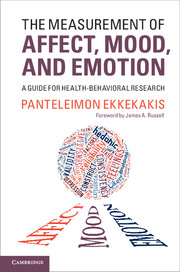Book contents
- Frontmatter
- Contents
- Figures
- Foreword
- Prologue
- 1 Documenting the breadth and depth of the problem
- 2 Untangling the terminological Gordian knot
- 3 Should affective states be considered as distinct entities or as positioned along dimensions?
- 4 Are pleasant and unpleasant states independent or polar opposites?
- 5 Selecting a measure
- 6 The old classics
- 7 Dimensional measures
- 8 Domain-specific measurement
- 9 Problems of domain specificity
- Epilogue
- References
- Index
5 - Selecting a measure
A proposed three-step process
Published online by Cambridge University Press: 05 March 2013
- Frontmatter
- Contents
- Figures
- Foreword
- Prologue
- 1 Documenting the breadth and depth of the problem
- 2 Untangling the terminological Gordian knot
- 3 Should affective states be considered as distinct entities or as positioned along dimensions?
- 4 Are pleasant and unpleasant states independent or polar opposites?
- 5 Selecting a measure
- 6 The old classics
- 7 Dimensional measures
- 8 Domain-specific measurement
- 9 Problems of domain specificity
- Epilogue
- References
- Index
Summary
The process of selecting a measure should ideally include the following steps (see Ekkekakis, 2008, 2012). The first step involves deciding which construct to target among the three main constructs that comprise the global domain of affective phenomena, namely core affect, mood, and emotion. This difficult question must be answered with clarity before one can move further along the process of selecting a measure.
The second step in the process entails a series of complex decisions and is thus at least as intellectually demanding as the first step. It involves choosing from among the different theoretical models proposed for conceptualizing the chosen construct. As explained in Chapters 3 and 4, measures do not (or, at least, should not) evolve in a theoretical vacuum; when one chooses a measure, one presumably also accepts or endorses the theoretical infrastructure upon which the measure was built. Arguably, it should be deemed inconceivable to choose a measure without having a firm understanding of the underlying theory or without being able to articulate the theoretical reasoning behind this choice. Researchers must recognize that, within the domain of affect, mood, and emotion research lies a multitude of theoretical perspectives. This cannot be ignored; researchers will encounter multiple bifurcations in the decision-making algorithm and must be prepared to argue in favor of one or the other option. These decisions have a defining impact on the data that will be collected, and, by extension, on the overall quality and meaningfulness of any study. As described in the previous two chapters, the differences between the options one must face are not slight or trivial. They typically represent diametrically opposite conceptual viewpoints and are often surrounded by intense intellectual battles that span several decades and dozens of published articles.
- Type
- Chapter
- Information
- The Measurement of Affect, Mood, and EmotionA Guide for Health-Behavioral Research, pp. 96 - 101Publisher: Cambridge University PressPrint publication year: 2013



